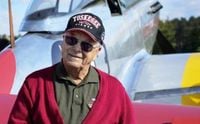Lt. Col. George E. Hardy, the last surviving Tuskegee Airman who flew combat missions in World War II, has died at the age of 100, marking the end of an era for a group that helped reshape the U.S. military and the nation’s understanding of race and excellence. Hardy’s passing on September 25, 2025, was confirmed by a spokesperson for Tuskegee Airmen, Inc., with tributes pouring in from those who knew him and those who admired his historic legacy.
Born on June 8, 1925, in Philadelphia, George Hardy’s journey from a young man in a segregated America to a decorated military officer is one that reads like a history lesson—one filled with adversity, courage, and achievement. At just 18, in July 1943, Hardy joined the U.S. Army Air Corps, driven by a desire to serve his country even as the country questioned the abilities and rights of Black Americans. By December of that year, he began pilot training at the famed Tuskegee Army Air Field, a program established to train the first Black aviators in the U.S. Armed Forces.
Hardy’s rapid progression through the ranks was remarkable. By September 1944, at only 19 years old, he had graduated from pilot training and was commissioned as a second lieutenant. He was soon assigned to the 332nd Fighter Group, famously known as the Red Tails, and stationed at Ramitelli Air Base in Italy. There, he joined the 99th Fighter Squadron—one of the most storied units in American military history.
During World War II, Hardy completed 21 combat missions across Europe. According to the U.S. Air Force, he was the youngest Red Tail fighter pilot among the Tuskegee Airmen, a distinction that underscored both his skill and the urgency of the times. The Tuskegee Airmen, as a group, shattered stereotypes and broke barriers, flying with distinction while facing discrimination both at home and abroad.
Hardy himself reflected on the complicated realities of serving overseas. In an interview with the Veterans History Project, he noted, “We had our own club in Naples…so you didn’t go to the White club. That’s…the way life was.” While he found that systemic racism was less overt in Italy than in the United States, segregation still shaped his daily existence. Yet, he and his fellow airmen persevered, earning respect through their abilities and conduct in the skies.
When the war in Europe ended in 1945, Hardy left Italy as a first lieutenant and returned to the Tuskegee Army Air Field, where he served as a supervising pilot until the base closed in 1946. Returning home to Philadelphia, he attended New York University and married in 1947, beginning a new chapter in his life that would soon see him return to service in a changing world.
In 1949, Hardy was assigned to the 19th Bomb Group, becoming the only Black American officer in the unit and stationed in Guam. The outbreak of the Korean War the following year saw him transferred to Okinawa, where he continued to break barriers and prove his mettle. During the Korean conflict, Hardy flew 45 combat missions, adding to his already impressive record.
But Hardy’s service did not end there. He would again answer his country’s call during the Vietnam War, flying an additional 70 combat missions. By the time he retired from military service in 1971, Hardy had amassed a record that few could rival—spanning three wars and decades of profound change in both the military and American society.
His military career was decorated with numerous honors. Hardy received the Distinguished Flying Cross with Valor, a Commendation Medal with one Oak Leaf Cluster, and an Air Medal with 11 Oak Leaf Clusters—testaments to his bravery, skill, and dedication. In 2007, he and other Tuskegee Airmen were awarded the Congressional Gold Medal, one of the nation’s highest civilian honors, recognizing their service and the obstacles they overcame.
Yet, for all his military achievements, those who knew Hardy say his greatest pride was not the medals or the missions, but his education. According to Leon Butler Jr., national president of Tuskegee Airmen, Inc., “Colonel Hardy was an amazing man. He was a patriot. He loved his family. He loved his community. He loved our organization. He worked very hard. He worked tirelessly to preserve the legacy, not for himself, but for those that he served with, and he cared about the families of other original Tuskegee Airmen.”
Hardy graduated from South Philadelphia High School before earning a bachelor’s degree in electrical engineering. He continued his studies, obtaining a master’s degree in systems engineering-reliability from the U.S. Air Force Institute of Technology. He was later honored with an honorary doctorate of public service from Tuskegee University—a fitting tribute from an institution synonymous with Black excellence and achievement.
According to NPR, Hardy’s life was defined by “courage, resilience, tremendous skill and dogged perseverance against racism, prejudice and other evils.” His story, and the story of the Tuskegee Airmen, is a reminder of the power of determination in the face of adversity. Despite systemic barriers and social exclusion, Hardy and his peers proved their worth not just as pilots, but as Americans whose service helped pave the way for a more inclusive military and society.
Hardy’s passing closes a chapter in American history, but his legacy continues. The Tuskegee Airmen’s legacy is preserved not only in museums and history books but in the opportunities now available to generations of Americans who follow in their footsteps. As the last of the combat-flying Tuskegee Airmen, Hardy’s life stands as a testament to the progress that can be made when courage meets opportunity—and when individuals refuse to be defined by the limitations others would set for them.
His journey from a segregated Philadelphia to the skies over Europe, Korea, and Vietnam, and finally to the halls of honor in the United States, will inspire for generations to come.
